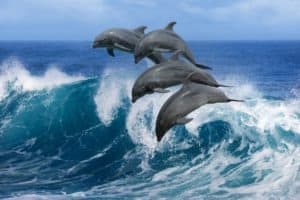Hybrid animals occur both in nature and through human intervention. Generally speaking, these odd-defying creatures live on land. We’ve seen ligers, coywolves, pizzly bears, and more. Today’s common hybrid is the mule or a cross between a horse and a donkey. Recently, scientists discovered that the ocean contains hybrid animals, too!
Today, we’ll take a look at the wholphin. Often, the result of a male false killer whale mating with a female bottlenose dolphin, these creatures are incredibly rare. This unbelievable hybridization is a tragedy in some ways. That’s because the populations of these creatures’ species are dwindling, so much so that they seek out other species for reproduction. However, this is not always the case. Let’s learn more about wholphins and other crazy animal hybrids!
The First Documented Wholphin

Kawilikai is the only living calf of the first wholphin hybrid, Kekaimalu.
© Mark Interrante / CC BY-SA 4.0 Deed – License
False killer whales are actually in the dolphin family, which is likely why these wholphin hybrids were possible. Nevertheless, the high mortality rate of these hybrids cannot be overlooked. Only two of the five known wholphin hybrids in captivity survived.
The first ever recorded wholphin, born at SeaWorld in Tokyo, died only 200 days after his birth.
The first wholphin that occurred in the United States became known as Kekaimalu. She was born at Sea Life Park in Hawaii in 1985. She also became the first wholphin to reproduce in 1990. Regrettably, the calf died shortly after that. In 1991, she birthed another calf that lived to nine years old but never bred. The third calf, Kawilikai, was born in 2004. According to the park’s website, Kekaimalu and Kawilikai live happily in their Dolphin Lagoon exhibit as of 2023.
Why Don’t Most Wholphin Calves Live?

Wholphins grow much larger than their bottlenose dolphin mothers.
©beaverboy56/Shutterstock.com
Kekaimalu’s two calves had the same male dolphin father. A different male dolphin sired Kawilikai. All the babies were three-quarter bottlenose dolphins and one-quarter false killer whales. No one knows for sure if the father’s genetics or the mother’s young age were at fault in the death of the first two calves. However, it may have been something else entirely. We will likely never know the definite answer.
When hybridization occurs, the resulting offspring have a mix of DNA from each parent. This mix doesn’t necessarily come out 50/50. Sometimes, the way the genes combine causes problems with the growth, bones, internal organs, or even the brain of the babies. Unfortunately, that means they cannot survive to become healthy adults. Most genetically mismatched hybrids pass away soon after birth. Some hybrids, such as mules, are sterile. That means they cannot reproduce.
Wholphins in the Wild
In 2018, scientists spotted another wholphin. This time, though, it was a male and a hybrid between a melon-headed whale and a rough-toothed dolphin. Spotted off the coast of Hawaii, researchers determined he was close to fully grown. Dr. Robin Baird, who headed the expedition that discovered the creature, stated that calling it a wholphin is very controversial. That’s because the melon-headed whale is another misnomer, as it’s also technically a dolphin. She did not provide another term to use, so the name stuck. This research group, Cascadia Research Collective, also identified some other ocean hybrids.
Other Ocean Hybrids
Besides wholphins, other sea animal hybrids also exist. Let’s take a look at a few!
The Narluga
The narluga is a cross between a female narwhal and a male beluga whale. A fisherman supposedly caught a living specimen of this creature at some point and decided to keep the skull. In 1990, researchers discovered the skull simply sitting on the roof of a shed in Greenland. Upon studying the skull and analyzing its genetics, scientists confirmed it once belonged to a living hybrid, a narluga.
In 2016, more researchers began to track a narwhal they found traveling with a pod of beluga whales. Robert Michaud, a marine biologist studying the strange pod, suspects narlugas may occur. He confirmed the narwhal is still with the pod as of March 2022. Now that the male narwhal is nearing maturity, Michaud’s research group is observing for narlugas!
Clymene Dolphin – The Original Wholphin

Clymene dolphins are the first and only marine mammal hybrids to become their species.
©Tara Lambourne/Shutterstock.com
The Clymene dolphin proves that hybridization is a natural process. While technically not a wholphin since both original species are officially called dolphins, this amazing hybrid came about all on its own in the wild. In the 1800s, researchers discovered odd hybrids between spinner and striped dolphins. They called them short-snouted spinner dolphins but later recognized them as their own species in 1981. The Clymene dolphin still holds the title of the only hybrid marine mammal to become its own species.
The photo featured at the top of this post is © Mark Interrante / CC BY-SA 4.0 Deed – License / Original
Thank you for reading! Have some feedback for us? Contact the AZ Animals editorial team.







